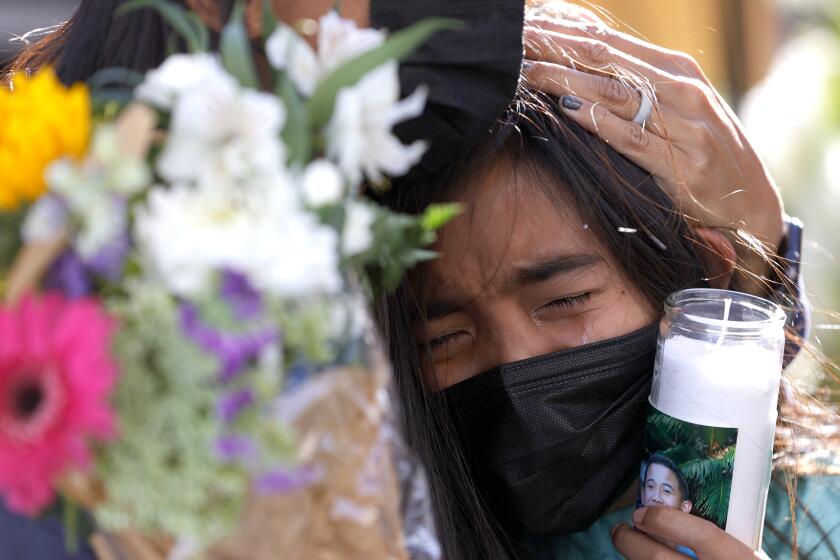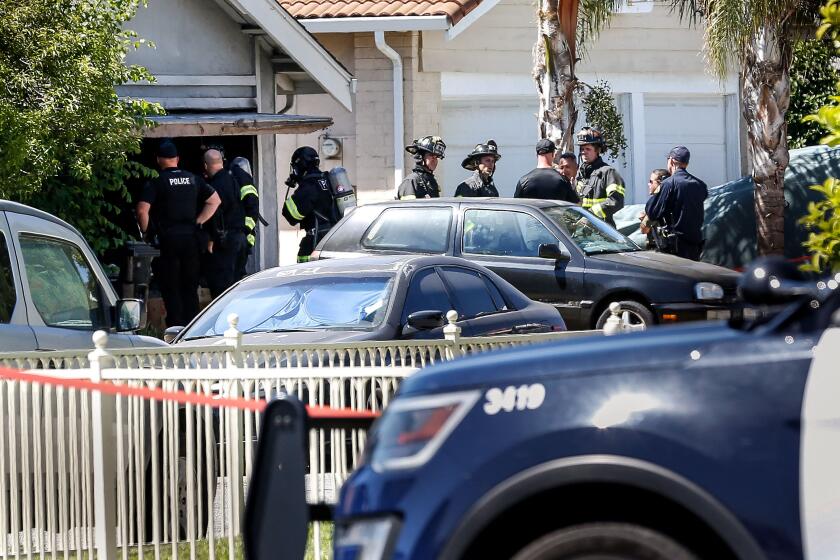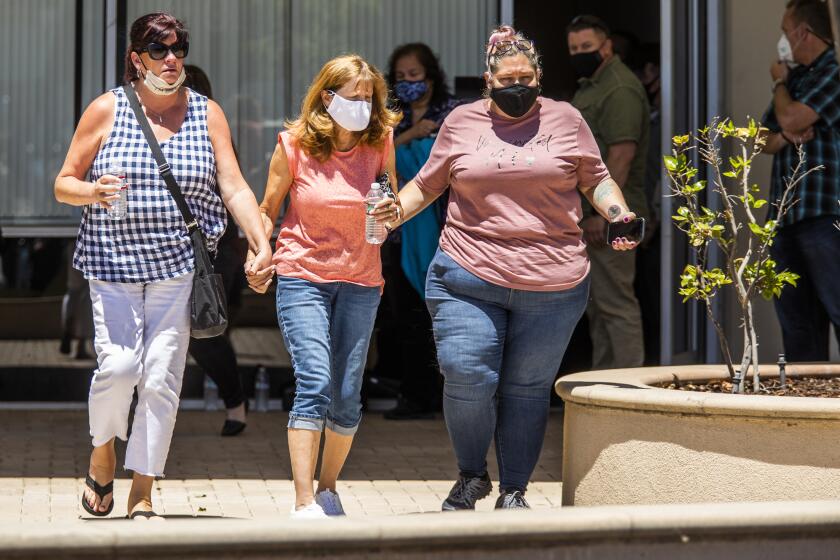He set his house on fire then killed 9 co-workers. Gunman’s rampage leaves San Jose reeling

A witness to Samuel Cassidy’s deadly rail yard shooting says the gunman appeared to target certain people: ‘He had a specific agenda.’
SAN JOSE — First, the gunman set his house on fire.
Then he drove to work Wednesday morning and shot nine co-workers to death in two separate buildings at a San Jose light rail yard, after possibly setting explosives.
As Santa Clara County sheriff’s deputies ran on scene just moments after the first 911 calls came in, he apparently shot himself to death.
The gunman set his own house on fire before driving to a union meeting at the VTA facility and shooting, authorities said.
Witnesses said the gunman wiped out most of the early shift at the Santa Clara Valley Transportation Authority facility, in California’s worst mass shooting of the year and one of the deadliest in the country in 2021.
“What the hell’s going on in the United States of America?” Gov. Gavin Newsom asked at an afternoon briefing after meeting with members of the victims’ families. “What the hell’s wrong with us? … When are we going to put down our arms, literally and figuratively?”
Law enforcement sources identified the alleged shooter as Samuel Cassidy, a 57-year-old maintenance worker who had been employed at the VTA for at least eight years.
Authorities are still searching for a motive in the shooting, although early indications point to a work-related issue that did not involve riders on the Silicon Valley’s light rail system. Investigators said Cassidy only targeted co-workers during the attack and did not fire at police.
Cassidy’s body was found at the scene, which was swarmed throughout the day with police officers, sheriff’s deputies, FBI agents and bomb experts, human and canine. As of midday Wednesday, explosives still had not been cleared from the rail yard, and the region’s light-rail service was suspended indefinitely.
Sources identified him as Samuel Cassidy, 57, a maintenance worker who apparently killed himself after killing eight transit employees.
Almost two years ago, another rampage sent shockwaves through Santa Clara County and beyond when a gunman opened fire on the famous Gilroy Garlic Festival, killing three people and wounding 17 others in 2019.
Santa Clara County Dist. Atty. Jeff Rosen noted that tragedy during a briefing Wednesday, saying, “Unfortunately, we have experience with mass shooting events.”
Authorities on Wednesday night identified the victims as: Paul Delacruz Megia, 42; Taptejdeep Singh, 36; Adrian Balleza, 29; Jose Dejesus Hernandez III, 35; Timothy Michael Romo, 49; Michael Joseph Rudometkin, 40; Abdolvahab Alaghmandan, 63; Lars Kepler Lane, 63; and Alex Ward Fritch, 49.
Cassidy lived in a beige stucco house with pale green trim in a working-class San Jose neighborhood near the 101 Freeway. The houses were modest, but, this being the Silicon Valley, prices run to the million-dollar level.
His neighbors knew Cassidy as a “very strange, very quiet” guy, said Ramon Crescini, 64, a retired general contractor who lives down the street. Crescini said he woke up Wednesday morning to see black smoke billowing from several doors down.
It took firefighters nearly an hour to get the two-alarm fire under control, said San Jose Fire Dept. Battalion Chief Jeff Fielding. Cassidy’s home was “completely destroyed,” Fielding said, and a neighboring house was damaged.
On Wednesday morning, the neighborhood was cordoned off by local and federal law enforcement agents, who discovered firearms and a large cache of ammunition in Cassidy’s house.
“They blocked the whole thing,” said Thang Lu, 57, an auto parts delivery worker. “A lot of crazy things are going on in San Jose. It is getting worse, not like the old days.”
Cassidy was divorced more than a decade ago. His ex-wife told the Mercury News that he had a mercurial temper and often complained that co-workers and family members had easier lives than he did.
But Cecilia Nelms of Santa Cruz said she never knew her ex-husband to own guns, and she could not link the man she had been married to for 10 years with the gunman who lay dead at the rail yard. Court records show that the couple married in 1994 and divorced in 2005.
“He had two sides,” Nelms told the Mercury News. “When he was in a good mood, he was a great guy. When he was mad, he was mad.”
But court documents paint a darker picture.
Cassidy sought a restraining order against a former girlfriend in March 2009. He wanted the court to bar the then-45-year-old from coming anywhere near him, his parents or any female houseguest.
He claimed the woman had grabbed him the year before, threatened him and promised to contact his employer and get him fired, according to court documents. The court granted the restraining order against the woman a month later.
In response, the former girlfriend alleged in a declaration that, during their yearlong relationship, Cassidy sexually assaulted her and “exhibited major mood swings as a result of bipolar disorder.”
“Those mood swings would be exacerbated when Petitioner consumed large quantities of alcohol,” the declaration said. The Times is not naming the woman, because she is a victim of an alleged sexual assault.
“Several times during the relationship he became intoxicated, enraged and forced himself on me sexually,” she said in the court filing. There were times, she said, when she refused to have sex and he would hold her arms and force himself on top of her.
She denied ever harming Cassidy, noting she was 5 feet 4 and he was 6 feet 1 and weighed 200 pounds.
Cassidy walked out of his San Jose home at about 5:40 a.m. Wednesday, carrying a black duffel bag. He was dressed in a safety jacket and pants with fluorescent strips. Images of Cassidy were captured on video by a neighbor’s surveillance camera.
He placed the bag into a white pickup truck. The surveillance video does not show him drive off. But less than an hour later, his house was in flames and he and eight others were dead. A ninth victim died Wednesday night.
Officials have not identified the kind of weapon used in the shooting. But Rosen, the Santa Clara district attorney, said “there were multiple guns, but not a ghost gun.” Ghost guns are homemade, untraceable firearms.
Family members spent much of the day at the American Red Cross of Silicon Valley, located in an industrial area of San Jose. Most declined to speak with reporters in the hours after the shooting.
Bagga Singh, who lives in Union City, waited at the center for word of his cousin, a train operator and father of two.
By Wednesday afternoon, he said the location-tracking device on his cousin’s phone showed it was still inside the building where the shooting occurred. He called the number over and over, he said, and so did other family members.
But the phone just rang and rang.
Singh would not share his cousin’s name. The man was one of several family members, all immigrants from India, who worked for the transit agency. But he was the only one on duty Wednesday morning, when the gunman carved his deadly swath through the rail yard.
“We’re just waiting for news,” Singh said.
No one, not even local hospitals, could provide any information, he said. The family hoped the cousin wasn’t answering his phone because he was with law enforcement agents, being interviewed about the attack.
The other possibility was just too painful to contemplate.
“There is nothing we can do,” Singh said. “We are here together to help each other.”
Santa Clara County moved quickly to help families of victims, but by day’s end, some were still trying to learn the fate of loved ones.
The cousin’s wife was with other family members inside the Red Cross building, he said, but they planned to send her home while they continued their vigil. They were among 60 to 70 family members waiting to find out the fate of their loved ones.
“It’s tense, you know, very tense,” Singh said. The building was filled with distraught people. Some were in tears. “Missing, you know, is a big problem.”
Newsom, who had spoken with several family members, said they were all in pain.
“They are waiting to know if their loved ones are alive,” he said. “They are dialing their loved ones, and they can’t find them. … [They were] desperate to find out if their brother, their son, their dad or their mom is still alive.
“The fact that they can stand up and support one another is remarkable.”
While California is known for its tough gun laws, it has been unable to avoid mass shootings that plagued nearly every part of the United States before the COVID-19 pandemic and have continued. These include recent mass shootings in Georgia, Colorado and Indiana.
President Biden said he and Vice President Kamala Harris were both briefed on the shooting. In a statement, he urged Congress to “heed the call of the American people, including the vast majority of gun owners” and pass legislation to help end the “epidemic” of gun violence in the country.
“Enough,” he said. “Every life that is taken by a bullet pierces the soul of our nation. We can, and we must, do more.”
Times staff writers Chris Megerian, Leila Miller and Jaclyn Cosgrove contributed to this report.
More to Read
Sign up for Essential California
The most important California stories and recommendations in your inbox every morning.
You may occasionally receive promotional content from the Los Angeles Times.

















